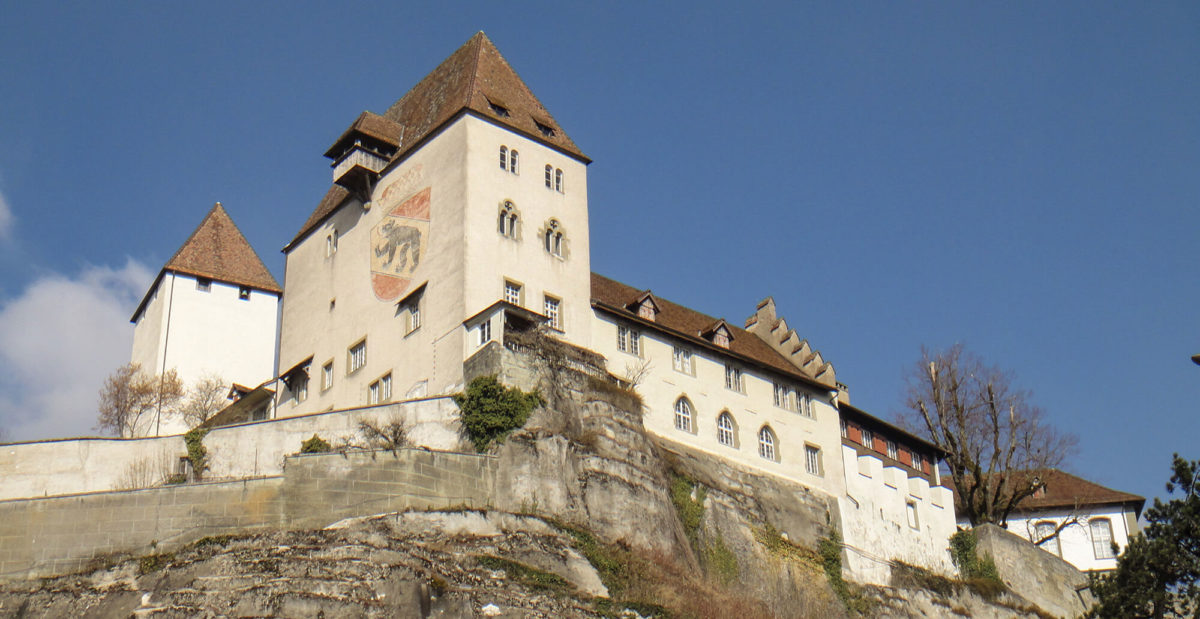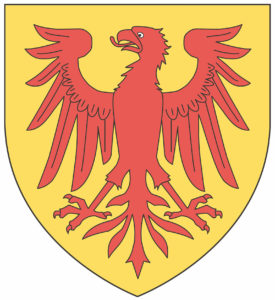
The history of the castle
Burgdorf Castle is 800 years old and is an iconic landmark of both the city and the region of Burgdorf. The imposing complex built by the Zähringens is a unique historical artefact and a monument of national significance.

The ‘red castle’ on the Night of Light 2020 © danielrohr.ch
The castle’s history
There is a myth surrounding the origins of Burgdorf Castle that was made into a poem by Jeremias Gotthelf. A terrible dragon and a fair maiden are said to have lived in the rock below the castle. In the year 712, the brave brothers Sintram and Bertram managed to defeat the monster and built a castle on the rock. At least, that’s what the legend says. Of course, the castle came about quite differently, though not much is known about its origins. All we know for sure is that the Counts of Rheinfelden owned a castle in Burgdorf which became the property of the Dukes of Zähringen in 1090.
Around the year 1200, Duke Berthold V, the last of the Zähringens, built a series of cities to strengthen his rule, including Burgdorf and, from there, Bern.
As part of this process, the castle was rebuilt in its current form with a residential tower (main building), fortified tower (keep) and great hall. The castle was built with brick – a material that was unfamiliar in the region at the time – giving it a particularly majestic red appearance. Its size makes it reminiscent of a royal residence. This, together with the large city church planned by the duke, indicates that Burgdorf was intended as the centre of Zähringen-ruled Burgundy.
After Berchtold V’s death in 1218, the castle passed to the noble Kyburg family. The castle served as a count’s residence until 1384. After losing the Burgdorf war in 1383, the Kyburgs were forced to sell the earldom of Burgdorf to the emerging city state of Bern. A Bernese ‘Schultheiss’ (municipal leader) then moved into the castle. The noble residence thus became a castle belonging to the authorities. While under Bernese rule, the castle underwent a few alterations and extensions, but the essential character of the building has remained the same since 1200.
Burgdorf Castle is considered to be the best-preserved of the Zähringen castles and is a historic monument of national significance. Today, it houses a museum, a restaurant and a youth hostel. It is also home to a municipal ceremony location and a banqueting hall.
Key dates
Circa 1200
In the late 12th century, the Dukes of Zähringen founded the city of Burgdorf and built a High Medieval fortress with an impressive residential castle on the sandstone mound by the Emme river.
1218 – 1383
The noble house of Kyburg inherited the Zähringen dynasty when it died out and moved into its ruling seat at Burgdorf, expanding the city and the castle. The Kyburgs were forced to sell the earldom of Burgdorf to the city state of Bern in 1383.
1384 – 1798
The emerging city state of Bern placed a Bernese ‘Schultheiss’ (municipal leader) in the castle. Changes were made to the castle by the state of Bern from the 15th to the 18th century. During this period, the gateway tower was built, the large hall from the Zähringen era was divided and the residential, administrative and business buildings were adapted to the requirements of the time.
1800 – 1804
After the fall of the Old Swiss Confederacy in 1798, the castle stood empty. During the era of the Helvetic Republic, the pedagogue Johann Heinrich Pestalozzi was able to run his schools and work on his writing from Burgdorf Castle.
1804 – 2012
Following the return of the federal structure, the canton of Bern used the castle for administrative purposes. During the second half of the 20th century, the castle was home to the Prefect’s office, the court and the regional prison. 1886 The Rittersaalverein Burgdorf opened a regional museum and continued to expand its collection of cultural and historic artefacts.
2000
The fortified tower became home to the Helvetic gold museum, the first of its kind in Switzerland.
2001
The museum of ethnology, which has existed in Burgdorf since 1909, moved into new exhibition spaces in the castle.
2012
The cantonal administration withdrew from the castle following the cantonal administrative reform.
2017
Work began on converting the castle into a public place with a museum, youth hostel, restaurant and space for wedding ceremonies.
2020
Reopening of Burgdorf Castle as a ‘castle open to all’.
Burgdorf Castle makes the top 25Burgdorf Castle is listed as one of the 25 most significant castles and fortresses in Switzerland and Liechtenstein: PDF extract. The publication Zeugen vergangener Macht und Herrschaft (‘Symbols of past power and dominion’) can be ordered from the Schweizerischer Burgenverein (Swiss castle association).
The Zähringens
 The Swabian royal house of Zähringen was related to the Hohenstaufen dynasty, and called itself Zähringen after its castle near Freiburg im Breisgau from the end of the 11th century. The ancestral home of the Zähringens was Limburg near Weilheim an der Teck, built by Berchtold I (circa 1000–1078). The Zähringens expanded to the west and later to the south. Today, there remain 12 Zähringen cities in southern Germany and Switzerland. Their links date back to the foundation of most of the cities. All of them once belonged to the Dukes of Zähringen. The Zähringens’ rule over their large estates was characterised by a uniform allocation of jurisdiction and numerous rights to the individual regions, which was progressive for the time.
The Swabian royal house of Zähringen was related to the Hohenstaufen dynasty, and called itself Zähringen after its castle near Freiburg im Breisgau from the end of the 11th century. The ancestral home of the Zähringens was Limburg near Weilheim an der Teck, built by Berchtold I (circa 1000–1078). The Zähringens expanded to the west and later to the south. Today, there remain 12 Zähringen cities in southern Germany and Switzerland. Their links date back to the foundation of most of the cities. All of them once belonged to the Dukes of Zähringen. The Zähringens’ rule over their large estates was characterised by a uniform allocation of jurisdiction and numerous rights to the individual regions, which was progressive for the time.
The Zähringen cities today
The 12 Zähringen cities remain connected today and aim to maintain and keep alive the cultural legacy of their ancestors. The cities are Bern, Bräunlingen, Burgdorf, Freiburg im Breisgau, Fribourg, Murten, Neuenburg am Rhein, Rheinfelden, Sankt Peter im Schwarzwald, Thun, Villingen-Schwenningen and Weilheim an der Teck. Duke Berchtold V was the last of the Zähringens and built Burgdorf Castle – the best-preserved Zähringen castle. The Zähringens and everyday life in the Middle Ages will play an important role at Burgdorf Castle going forward. The affordable accommodation provided by the youth hostel enables school groups to spend several days in this authentic setting and experience history first-hand. This is also facilitated by the group activities at the museum.